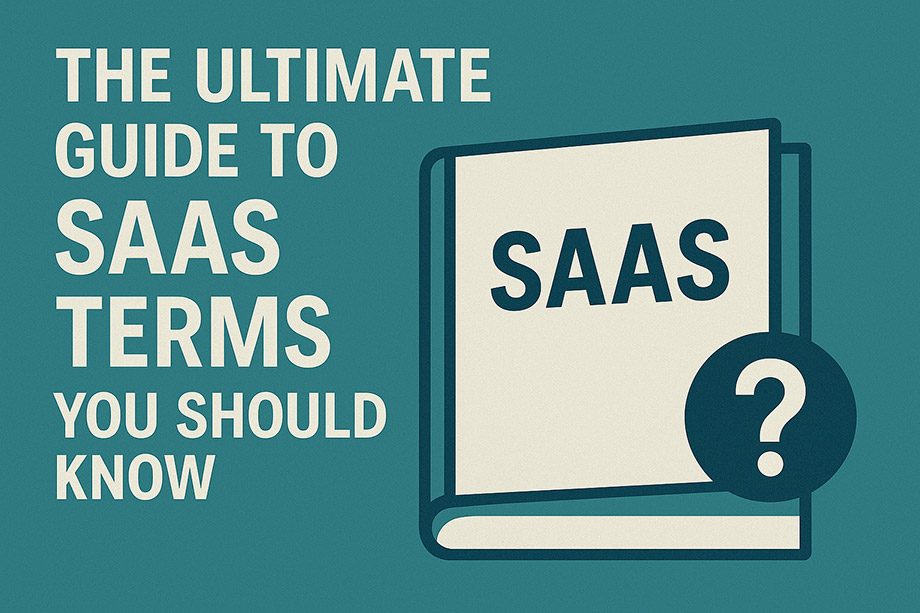The Ultimate Guide to SaaS Terms You Should Know

If you work with SaaS products or want to understand this fast-growing industry, knowing the key terms makes a huge difference. SaaS, or Software as a Service, has its own language full of metrics, business models, and technical jargon. Understanding these terms helps you follow conversations, make better decisions, and communicate clearly with your team or clients. This guide covers the most important SaaS terms with clear explanations and practical insights to help you grasp why they matter and how to use them.
What Is SaaS?
SaaS or Software as a Service means delivering software over the internet instead of installing it on your device. You pay a subscription, usually monthly or yearly, and access the software through a browser or app. This model offers flexibility, easier updates, and scalability. Popular SaaS products include Slack, Zoom, and Dropbox. Understanding SaaS starts with knowing how the business makes money and measures success.
Financial Metrics
Monthly Recurring Revenue (MRR): Predictable revenue expected every month from subscriptions. Unlike one-time sales, MRR helps you forecast growth and plan investments.
Annual Recurring Revenue (ARR): MRR multiplied by twelve to show yearly income.
Customer Acquisition Cost (CAC): How much you spend on marketing and sales to acquire one new customer.
CAC Payback Period: The time it takes to recover the money spent on acquiring a customer.
Lifetime Value (LTV): The total revenue a customer will bring over their lifetime with your company.
LTV:CAC Ratio: Compares LTV to CAC to determine if acquiring customers is profitable. Above 3:1 is healthy.
Churn Rate: The percentage of customers or revenue lost over time. Includes voluntary churn (customers cancel by choice) and involuntary churn (due to failed payments or account issues).
Net Revenue Retention (NRR): Percentage of recurring revenue retained from existing customers after accounting for expansions, contractions, and churn. Over 100% means revenue growth within the customer base.
Burn Rate: The speed at which a company spends its cash reserves.
Magic Number: A sales efficiency metric comparing new revenue growth to sales and marketing spend.
Customer & Growth Metrics
Monthly Active Users (MAU): Unique users engaging with your product monthly.
Daily Active Users (DAU): Unique users engaging daily.
Activation Rate: Percentage of users who complete a key first milestone demonstrating product value.
Trial-to-Paid Conversion Rate: Percentage of trial users who become paying customers.
Net Promoter Score (NPS): Measures customer loyalty by asking how likely users are to recommend your product.
Cohort Analysis: Tracking groups of users over time to understand retention and behavior.
Feature Adoption Rate: Percentage of users actively using a specific feature.
Customer Health Score: A metric combining signals like usage and support interactions to predict retention.
Customer Journey: The complete experience a customer has with your product, from discovery to renewal or churn.
Technology & Product Terms
API (Application Programming Interface): A set of protocols that let software applications communicate and integrate.
API Rate Limiting: Restrictions on how many API requests a user or app can make in a given time to prevent overload.
Cloud Computing: Hosting software and data on remote servers accessible via the internet.
Service Level Agreement (SLA): A contract defining the service levels a vendor guarantees, such as uptime and support response.
Multitenancy: Software architecture where a single instance serves multiple customers while keeping their data separate.
Single Sign-On (SSO): User authentication method allowing one login for multiple applications.
Sandbox Environment: A safe testing space isolated from live data for trying new features.
Technical Debt: Extra work caused by choosing quick fixes over better-designed solutions.
Versioning: Maintaining different versions of software or APIs to ensure compatibility.
Webhooks: Methods for apps to send real-time updates based on specific events.
Data Residency: Policies or laws dictating where customer data must be stored geographically.
Pricing Models & Business Terms
Freemium: Offering a free basic version with paid upgrades.
Usage-Based Pricing: Charging customers based on how much they use the product.
Annual Contract Value (ACV): Total revenue expected from a customer contract in one year.
Expansion Revenue: Additional revenue from existing customers through upselling or add-ons.
Customer Lifetime (Customer Lifespan): Average time a customer remains subscribed.
Growth & Strategy Concepts
Land and Expand: Starting with a small deal and growing revenue by selling more seats or features within the same customer.
Go-to-Market (GTM) Strategy: Plan for launching and selling your product to the right customers using the right channels.
Product-Led Growth (PLG): A strategy where the product drives user acquisition and retention more than marketing or sales.
Revenue Operations (RevOps): Aligning sales, marketing, and customer success to improve revenue growth efficiency.
Referral Marketing: Encouraging customers to recommend your product to others to drive organic growth.
Customer Success & Operations
Customer Success: Teams focused on helping customers achieve their goals and reducing churn.
Dunning Management: Processes to recover revenue from failed payments by sending reminders or retrying charges.
Churn Types: Voluntary vs. Involuntary: Voluntary churn happens when customers cancel intentionally; involuntary churn results from payment failures or account issues.
Why These Terms Matter
Understanding these SaaS terms helps you read reports, grasp growth drivers, and communicate clearly with your team or clients. They connect product performance, customer experience, and business outcomes in a meaningful way. Whether you’re in product, marketing, sales, or customer success, mastering this language makes your work more effective.

